Old Field Management
2/14/2018 10:08:46 AM
By Craig Harper, University of TN, and John Gruchy, MDWFP
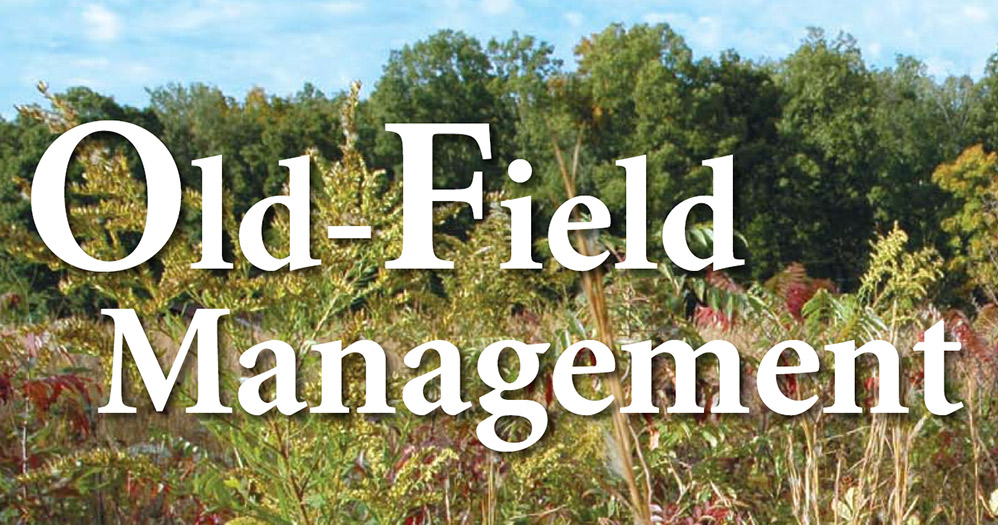
If you ask 10 deer managers how they could increase nutrition for deer in a field, probably nine out of 10 would say “plant a food plot.” Without question, food plots can be an important management practice when maximizing available nutrition for whitetails, but there are other ways to manage fields that positively influence food and cover.
Do you have a field you have to mow every year to keep it from “growing up”? How would you like to improve avail-able nutrition for deer in that field without planting anything? At the same time, how would you like to enhance fawning and winter cover in that field? What about maintaining it without mowing? Read on and we’ll tell you how to manage an “old-field” – what biologists refer to as early succession habitat – to produce benefits for deer through all seasons. It’s easier than you might think.
FIELD COMPOSITION AND WHY IT’S IMPORTANT
Forbs — Forage and Cover
Approximately 70 percent of a deer’s diet during spring and summer is forbs. Forbs are broadleaf herbaceous plants and represent a very important food group for deer. Many forbs are planted, such as clovers, chicory, soybeans, and cowpeas, but most occur naturally. Some of these naturally occurring forbs are eaten by deer. Some are not. The trick is to identify the ones deer like and manage the field to promote them while getting rid of the others.
Some of the more desirable forbs for whitetails include pokeweed, old-field aster, beggar’s-lice, Carolina geranium, ragweed, wild strawberry, perennial sunflowers, some of the goldenrods, and many others. Don’t worry if you’re not an amateur botanist. Buy a plant identification field guide. All of us can look at a quality color picture and match it to a plant in the field. The nutritional quality of many naturally occurring forbs rival any plant included in your favorite food plot (see Table 1 on page 18). The best part is they are free, and they require no management through the growing season! Of course, nutritional quality is influenced by plant maturity; however, most of these plants produce new leaves from the time they germinate until they flower. Thus, quality forage is produced throughout the growing season.
Not only do many forbs provide quality forage, they also provide excellent cover. Many naturally occurring forbs are 3 to 6 feet in height by the time most fawns are dropped in June. And unless they are mowed down, many of these plants remain erect through winter and provide deer a place to bed in the middle of the day, where they can remain hidden and absorb the sun’s warm rays.
Grass — Cover and Fuel
The primary component in most old-fields is grass. All grasses, however, were not created equally. Unfortunately, many fields are carpeted with non-native cool-season grasses, such as tall fescue and orchardgrass, or non-native warm-season grasses, such as bermudagrass. These grasses are most undesirable as they offer poor-quality forage and cover for deer, and they displace preferable plants and inhibit the seed bank from germinating.
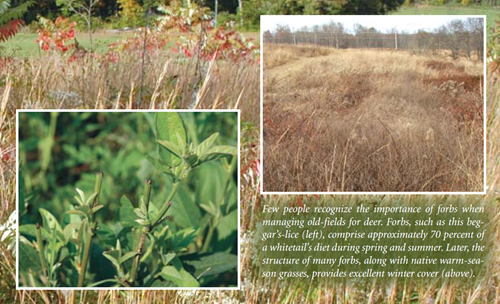
Yes, we have all found fawns in a tall fescue field that wasn’t hayed in June, and we have seen deer eating orchard-grass. We have also seen human beings eating out of trashcans and sleeping on the sidewalk. The point is, what we observe is not necessarily the way things should be. Sometimes animals, like humans, eat certain things and use certain habitats because nothing else is available. If the fawns on your property are forced to bed in tall fescue fields and the adult deer are limited to eating orchardgrass, rest assured that is an indication of overall poor-quality habitat. Without question, you can do much to improve the quality of cover and available nutrition just by getting rid of these grasses and allowing the seed bank to respond!
Desirable grasses in old-fields include several species of native warm-season grasses (NWSG), specifically big and little bluestem, broomsedge bluestem, indiangrass, switchgrass, and eastern gamagrass. These grasses are preferable to the non-native grasses mentioned above because NWSG provide better fawning cover and winter cover. NWSG are not, however, promoted for food. Deer eat very little grass of any kind during the summer. In winter, while non-native grasses provide virtually no cover whatsoever, NWSG can provide deer with outstanding winter cover, especially if there is a desirable forb component growing with the grasses that helps provide structure.
Cover is not the only benefit of NWSG in an old-field. When it comes time to manage the field, grass cover is essential to carry prescribed fire. Without grass, it can be quite difficult to burn a field because of a lack of fine fuels near the ground. Without fine fuels to carry the fire, excessive wind is needed to burn a field of forbs, which typically have only a single stem from the ground up to 2 feet or more where the dead foliage occurs. As we’ll cover later, fire is an integral component in old-field management.
Shrubs and Brambles — Don’t Fear Them!
Do you look at a field that contains shrubs and brambles and cringe? If so, you need to put on your rose-colored glasses. These are some of the most important plants in the field! Sumac, blackberry, wild plum, elderberry, crabapples, hawthorn – all of these and others provide an excellent source of food and cover within old-fields. Unfortunately, the brushy appearance of these species in an old-field often gets them “bush-hogged” before they can provide any benefit.
To enable an old-field to provide maximum benefit for deer, it is absolutely critical that you allow forbs, grasses, and shrubs and brambles to develop. A field of pure NWSG may provide cover, but its overall value for deer is far less than an old-field with more diverse vegetation.
FIELD RENOVATION
Get Rid of the Carpet
Your first step in enhancing an old-field is to eradicate the non-native grasses. We like to call this “removing the carpet.” Why? Because cool-season grasses and bermudagrass form a mat over the field that inhibits the seed bank from germinating. When this carpet is removed, seeds in the top few inches of soil are able to germinate, and desirable plants can be promoted. This is where your forbs come from. We think it is analogous to removing an ugly shag carpet in an old house and finding a beautiful hardwood floor underneath.
The only way to get rid of the carpet is by spraying the appropriate herbicide. Moldboard plowing will not eradicate problem grasses, such as tall fescue, orchardgrass, bermudagrass, and johnsongrass. Within two years, they will be back. Different grasses require different herbicides and different spraying techniques. Regardless, before spraying, it is critical to prepare the field for spraying by burning or haying. You must spray actively growing grass, and you don’t want dead leaves and stems to block the herbicide from coming in contact with the target plant.
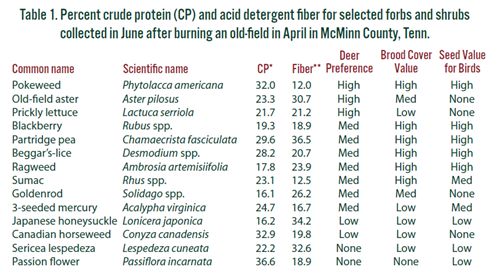
*Forage samples contained leaves only because that was the part of the plants deer commonly ate. Stems were not included. **Low fiber is desirable because plants are more easily digestible.
It is important to note that while deer are selective in what they eat, plants are not necessarily eaten based on nutritional content. While pokeweed, old-field aster, and prickly lettuce were browsed heavily, blackberry, partridge pea, beggar’s-lice, ragweed, goldenrod, and 3-seeded mercury were only browsed moderately. Japanese honeysuckle, a highly preferred deer forage in many southern locations, had a low preference value in this study. For other species, such as passion flower and sericea lespedeza, there was no sign of browsing at all, even though crude protein and digestibility ratings were high. Deer density in this area was approximately 25 per square mile and quality forage was not lacking as there were plenty of soybean fields as well as warm- and cool-season food plots on the farm. Also shown is the estimated value of these plants for wild turkeys and bobwhite quail.
To get rid of perennial cool-season grasses, prepare the field for spraying by burning or haying in September (August if you are in the North). After burning, the cool-season grasses will grow with a vengeance. Allow the grasses to grow 6 to 10 inches, then spray with a glyphosate herbicide. Spraying in the fall is recommended because a better kill is realized versus spraying in the spring and also because desirable NWSG and forbs are not harmed by fall spraying.
To eradicate non-native warm-season grasses, spray in the summer. Spray bermudagrass with Arsenal in late June, about the time bermudagrass begins to flower. Spray johnsongrass with a glyphosate herbicide when it reaches about 18 inches in height. If johnsongrass is growing among desired plants, such as broomsedge or blackberry, use an imazapic-based herbicide, such as Plateau, and you will not harm many desirable plants.
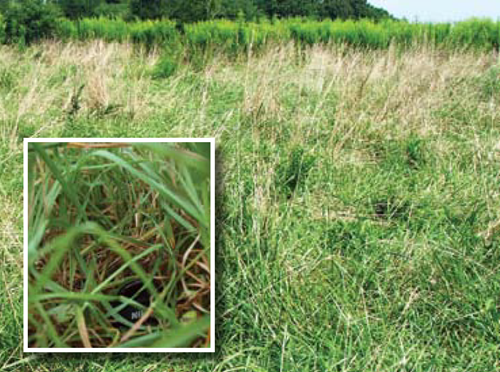
The first step in renovating an old-field for deer and other wildlife is to eradicate the non-native grasses, such as tall fescue and orchard-grass (inset). These grasses are extremely low preference forages for deer and provide no cover during winter. Further, these grasses act as a carpet over the field, smothering the seed bank and inhibiting more desirable plants from germinating.
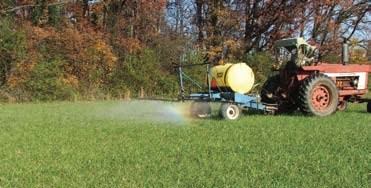
Fall is the best time to spray perennial cool-season grasses. Before spraying, it is essential to prepare the field by haying or burning to encourage fresh grass growth and remove dead plant material that will block herbicide contact.
Be Patient!
Patience is a virtue, and this is certainly true when renovating old-fields for wildlife. Even if you sprayed problem grasses exactly as recommended, there will usually be some residual growth the following year. This is not a problem – just spot spray as needed. Rome wasn’t built in day, and your old-field is not going to provide perfect habitat overnight. It will take two to three years to develop.
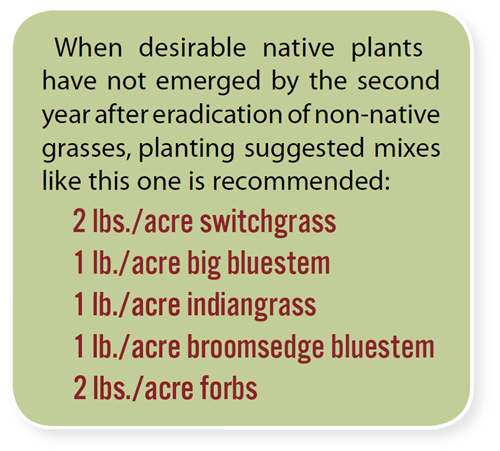
Once you have gotten rid of the carpet, you must wait and see what the seed bank contains. Often, desirable plants recolonize the site quickly. But sometimes, one non-native problem is followed by another. For example, it is not uncommon to eradicate one carpet of tall fescue only to find another carpet of bermudagrass or johnsongrass lying underneath. Or, problem forbs such as sericea lespedeza or thistles might arise. That’s OK – don’t be discouraged! It just means you have some more spraying to do. With persistence, you will get rid of all the old carpet layers and stimulate the plant community you are looking for. This will not happen, however, unless you diligently eradicate the invasive non-native plants that suppress the desirable plants.
Do You Need to Plant?
We hardly ever recommend anyone plant NWSG and associated forbs until they have waited at least one to two years after killing the non-native grass cover. As soon as the non-native cover is killed, there will be plants germinating from the seed bank. Most of these will be annuals. The perennial plants will increase over the next two years. Remember, these plants have been smothered by a carpet for many years, just waiting for a chance to germinate. Often, it takes time to develop the plant community you want. Nonetheless, if desirable plants are not present during the second year after eradicating the non-native grasses, it is time to think about planting the following spring.
A wide variety of native grass and forb seed is available from several suppliers. When managing the field for deer is the main objective, we recommend planting 5 to 6 pounds of native grasses with at least 1 to 2 pounds of forbs, per acre (a suggested mixture is shown here). Be sure to use varieties of NWSG indigenous or adapted to your area. And remember the desirable forbs and shrubs we mentioned earlier.
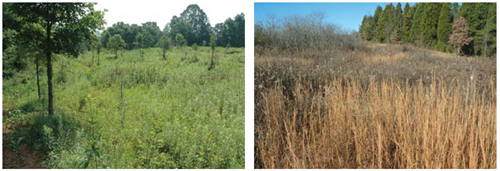
There is no need to plant if the seed bank already contains desirable species. This field was a tall fescue hayfield. Once the carpet was removed, the native seed bank flourished. Now, there is broomsedge bluestem, switchgrass, and eastern gamagrass throughout the field, along with blackberry, ragweed, beggar’s-lice, and many others, providing excellent fawning cover, forage, and winter cover. Note: the photo on the left was taken in July; on the right, November.
Fertilization – Is It Necessary?
Plants native to a particular area generally do not require fertilization to grow. However, just as with your food plots, fertilizing old-fields will stimulate additional plant growth, increase palatability, and provide more nutrition for deer. In areas with poor soils, fertilization may also enable plants to provide better cover. Nutrient-deficient grasses and forbs typically do not grow as tall and robust as those on better sites. On relatively poor sites, add 30 to 60 lbs./acre of nitrogen in late April/early May and make sure 50 to 100 lbs./acre of phosphorus and 200 to 250 lbs./acre of pot-ash are available. Of course, you won’t know nutrient availability unless you have soil samples tested. It is also important to realize the benefits of fertilization are much reduced unless you have adjusted pH to 6.0 to 7.0.
COMPOSITION AND MANAGEMENT
Plant composition within the field is influenced by management. We like to maintain approximately 50 percent grass cover intermixed with 50 percent forb cover with patches of shrubs and brambles scattered throughout the field (no more than 100 yards apart). After four to five years, grass coverage may increase. When grass coverage exceeds 70 percent, we balance the composition by disking in February/March or burning in September. In the meantime, we maintain desirable plant composition by burning every two to four years in late winter/early spring, and control any problem plants that arise by spot spraying, usually in the spring.
Burning
Using prescribed fire is by far the single-best management practice for maintaining early succession communities. Burning consumes dead plant material, and nutrients from the ashes are then moved via rainfall into the top couple inches of soil. This typically increases plant nutrition the following growing season. As dead plant material is consumed, an open structure is created at the ground level. This allows the seed bank to germinate and creates optimum conditions for brooding wild turkeys and bobwhites as they are able to pick up seeds and bugs under a protective canopy of forbs.
When maintaining the existing composition in the mid-South, we burn from mid-March through mid-April. This does not destroy winter cover until the onset of spring and does not negatively influence nesting. We do not recommend burning all cover in one year. If you only have one or two fields, split each field in half with a firebreak and manage the sections on a different rotation. If you have several fields, you may burn entire fields on a different rotation.
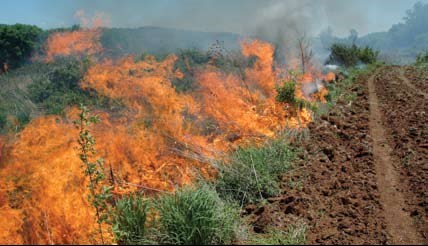
Old-fields should be maintained with prescribed fire. Burning sets back succession, recycles nutrients, consumes dead vegetation and stimulates the seed bank. Season of burning and frequency of burning influence plant composition. Here, we are rejuvenating our native grasses and reducing a few undesirable plants by burning in the early growing season (April). Burning is much more efficient and effective when managing early succession habitats than mowing.
Burning can also be used to reduce woody cover. If undesirable woody species (such as sweetgum, red maple, winged elm and green ash) begin to encroach into the field, burn the field in September/early October, before the leaves begin to turn color. Burning at this time effectively kills the tree by severing the cambium layer inside the bark and preventing the flow of carbohydrates down to the root system. If you burn these saplings in the dormant season, you will find three sprouts where there was one! Protect your blackberry patches, wild plum thickets, and sumac stands from fire (unless you want to decrease their cover-age) by disking around them, which provides other benefits.

Before burning, it is imperative to establish safe firebreaks around the field. Firebreaks can be planted in various food plot plantings adjacent to quality cover. Here, oats are providing quality forage in February in a firebreak that was well positioned outside the dripline of the trees to allow a soft edge to develop between the woods (left) and the field (far right).
Disking
When grass density approaches 70 percent, we increase forb coverage by disking strips 50- to 100-feet wide, evenly distributed across the field. In succeeding years, we rotate disked strips to maintain the overall composition within the field. Rotating these strips is very important to maintain desirable forage plants for deer (see the chart at left). Ideally, disking should be conducted in February in the Deep South and March in the mid-South and the North. Disking at this time enables cover to stand through winter and promotes more favorable forbs. Disking later into spring may stimulate undesirable species, such as johnsongrass, crabgrass, and sicklepod.
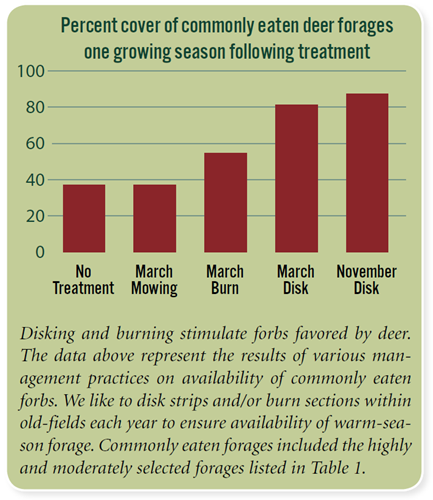
Disking is also used to maintain firebreaks. If you are going to burn, it is necessary to create firebreaks one to two tractor-widths wide to keep fire from spreading outside the field. To make things more fun and provide additional nutrition, we plant our firebreaks as food plots. We like to keep some sections in warm-season forages and grain and others in cool-season forages. This way, we have an ample supply of quality forage around the field, even during winter, adjacent to a fantastic cover source. Like to bow-hunt? We position our firebreaks approximately 50 feet from the woods edge to reduce competition for sunlight and nutrients and allow a soft edge of brush to develop around the field, which provides a perfect bow shot for deer feeding along the firebreak. This technique also allows you to hunt in more than one wind direction.
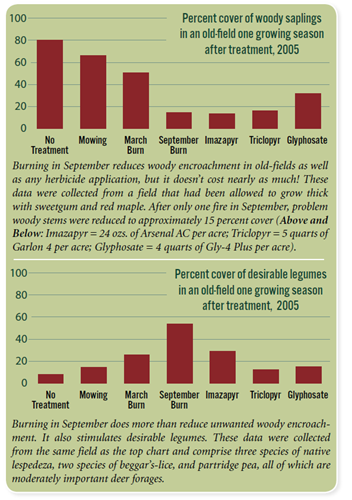
Mowing
We consider mowing the least desirable management technique for maintaining old-fields and recommend against it if at all possible. Some folks promote mowing, especially during the growing season, because they feel it stimulates additional growth and increases nutritive value of plants. This is true for grasses, but grasses are not an important food item for deer during the summer. Mowing during the summer increases grass dominance and decreases forb coverage. The exception to this is perennial clovers, which respond well when mowed or grazed. We are not concerned with clovers in our old-fields, however, because we manage for clovers in our food plots and firebreaks. We are more concerned with providing quality cover and structure in our old-fields. The forbs we are promoting in our old-fields provide cover and forage.
Mowing accumulates debris at the ground layer and suppresses the seed bank. Further, mowing during the growing season not only destroys fawning and nesting cover but often destroys fawns and nests. Nonetheless, some managers are prevented from burning by regulation or narrow windows of opportunity based on climate. If you cannot burn or disk, then mow in late winter, just prior to spring green-up. This allows deer the opportunity to use the cover through the winter and does not destroy fawning or nesting cover during spring and summer.
Final Thoughts
We often ask quail and rabbit hunters why they always hunt around the edges of fields. The answer is obvious – that’s where the quail and rabbits are. But why? Because that’s where cover for quail and rabbits exist. Why is this? Because the composition and structure of the field differs from that along the edge. Why? Because the field is not managed correctly for quail and rabbits. We ask, why not create a “field of edge”? That way, you will jump as many quail and rabbits from the middle of the field as you do around the edge! The same principle applies to deer. Instead of watching deer eat forbs and browse around the edge of the field and instead of waiting for deer to come to a field from a distant thicket in the woods, why not create a field of cover and food, naturally? Why not increase the amount of usable space on your property and enable your property to carry more deer? We think you will enjoy your efforts, and the deer and other wildlife will too!
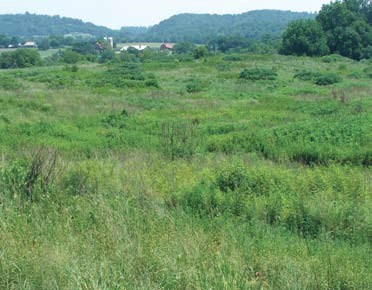
This field on the Mayfield Farm in McMinn County, Tenn., shows the perfect plant composition when managing old-field habitats for deer and other species of wildlife. Native grasses, forbs and scattered shrubs, providing both food and cover. This is a Leopold Landscape!









